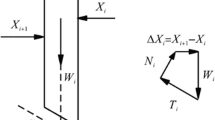This paper presents a mathematical model of the simultaneous processes of moisture, heat, and salt transfer in a porous medium, as well as a pattern of calculation of earth stability on a slope depending on the above factors and nonlinear dependences on them of the strength characteristics of the earth. The corresponding boundary-value problem has been solved by the method of radial basis functions. A comparison has been made between the results of numerical experiments showing the relationship between the change in the value of the safety factor and the position of the slip curve depending on the heat, salt, and moisture transfer.
Similar content being viewed by others
References
State Standard GOST V.1.1-3-97. Engineering Protection of Territories, Buildings, and Structures from Landslides and Avalanches. General Principles [in Russian], Gosbud Ukrainy, Kiev (1998).
State Standard GOST A.2.1-1-2008. Engineering Surveys for Construction [in Russian], Minregionbud Ukrainy, Kiev (2008).
State Standard GOST V.1.1-25-2009. Protection from Dangerous Geological Processes. Basic Principles of Design [in Russian], Minist. Vopr. ZhKKh Ukrainy, Kiev (2008).
N. N. Maslov, Soil Mechanics in the Practice of Construction (Landslides and Measures) [in Russian], Stroiizdat, Moscow (1977).
A. W. Bishop and N. Morgenstern, Stability coefficients for earth slopes, Geotechnique, 10, No. 4, 164−169 (1960).
J. Krahn, Stability Modeling with SLOPE. An Engineering Methodology, 1st edn., revision 1, GEO-SLOPE International Ltd., Calgary, Alberta (2004).
E. Spencer, A method of analysis of the stability of embankments assuming parallel interslice forces, Geotechnique, 17, No. 1, 11–26 (1967).
N. R. Morgenstern and V. E. Price, A numerical method for solving the equations of stability of general slip surfaces, Comput. J., 9, Issue 4, 388−393 (1967).
V. G. Fedorovskii and S. V. Kurilo, Method to calculate the stability of hillsides and slopes, Geoékologiya, No. 6, 95−106 (1997).
Ya. H. Huang, Stability Analysis of Earth Slopes [Russian translation], Stroiizdat, Moscow (1988).
P. L. Ivanov, Soils and Foundations of Hydrotechnical Structures. Soil Mechanics, Textbook for Special Hydrotechnical Universities [in Russian], Vysshaya Shkola, Moscow (1991).
S. B. Omuraliev, Influence of moisture content on the strength properties of loamy soils at in-plane shear, Vestn. Kyrgyzsko-Rossiiskogo Slavyansk. Univ., No. 7, 19–23 (2006).
O. S. Kovrov, Estimation of the effect of hydrogeological characteristics of soils on the stability of natural slopes to predict landslides, Ékol. Bezop., No. 1, 72–76 (2013).
T. V. Kutya and P. M. Martynyuk, Mathematical simulation of the wetting of the slope earth as a result of a nonramming pipeline with account for the processes of heat and salt transfer, in: Physicomathematical Modeling and Information Technologies, Issue 19, 107−115 (2014).
V. P. Petrukhin, Building Properties of Salted and Cemented Soils [in Russian], Stroiizdat, Moscow (1980).
O. R. Michuta, Mathematical simulation of the effect of multicomponent chemical solutions and nonisothermal conditions on the processes of soil consolidation in a two-dimensional case, Mat. Komp. Modelir., Ser. Tekh. Nauki, Issue 6, 143−153 (2012).
T. V. Pham and D. J. Fredlund, The application of dynamic programming to slope stability analyses, Can. Geotech. J., No. 40, 830–847 (2003).
J.-G. Caputo and Y. A. Stepanyants, Front solutions of Richards′ equation, Transp. Porous Media, 74, Issue 1, 1−20 (2007).
Feike J. Leij, Walter B. Russell, and Scott M. Lesch, Closed form expressions for water retention and conductivity data, Ground Water, 35, No. 5, 848–858 (1997).
P. N. Vabishchevich and A. O. Daniyarov, Mathematical simulation of the wetting of the aeration zone under the conditions of a high position of ground waters, Mat. Modelir., 6, No. 11, 11−24 (1994).
A. P. Vlasyuk and P. M. Martynyuk, Numerical Solution of the Problems of Consolidation and Filtrational Breakup of Soils under the Conditions of Heat and Mass Transfer by the Method of Radial-Basis Functions [in Russian], Nats. Univ. Vodn. Khoz. Prodov., Rovno (2010).
E. A. Vlasova, V. S. Zarubin, and G. N. Kuvyrkin, Approximate Methods of Mathematical Physics [in Russian], Izd. Moskovsk. Gos. Tekhn. Univ. im. N. É. Baumana, Moscow (2001).
E. J. Kansa, Multiquadrics — a scattered data approximation scheme with application to computational fluid-dynamics. II. Solutions to parabolic, hyperbolic and elliptic partial differential equations, Comput. Math. Appl., 19, Nos. 8–9, 147−161 (1990).
V. M. Kolodyazhnyi and O. Yu. Lisina, Numerical schemes of solving boundary-value problems on the basis of meshless methods using radial basis functions and atomic radial basis functions, Probl. Mashinostr., 13, No. 4, 49–56 (2010).
A. P. Vlasyuk and P. M. Martynyuk, Mathematical Simulation of Consolidation of Soils in Filtration of Salt Solutions under Nonisothermal Conditions [in Russian], Nats. Univ. Vodn. Khoz. Prodov., Rovno (2008).
F. P. Vasil’ev, Optimization Methods [in Russian], Faktorial Press, Moscow (2002).
I. V. Beiko, P. M. Zin’ko, and A. G. Nakonechnyi, Optimization Problems, Methods, and Algorithms [in Russian], Nats. Univ. Vodn. Khoz. Prodov., Rovno (2011).
G. Yilmaz, The effects of temperature on the characteristics of kaolinite and bentonite, Sci. Res. Essays, 6, No. 9, 1928–1939 (2011).
Author information
Authors and Affiliations
Corresponding author
Additional information
Translated from Inzhenerno-Fizicheskii Zhurnal, Vol. 91, No. 5, pp. 1256–1265, September–October, 2018.
Rights and permissions
About this article
Cite this article
Kutya, T.V., Martynyuk, P.N. Mathematical Simulation of Humidification of Earth on a Slope and Calculation of Its Safety Factor. J Eng Phys Thermophy 91, 1189–1198 (2018). https://doi.org/10.1007/s10891-018-1848-2
Received:
Published:
Issue Date:
DOI: https://doi.org/10.1007/s10891-018-1848-2




